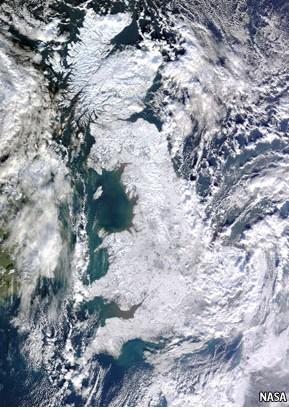(单词翻译:单击)

Science and Technology
科技
Climate and the solar cycle
气候与太阳周期
Chilling out in the winter sun
冬日下的冷噤
Stratospheric changes can lead to nasty cold snaps
平流层变化引起讨厌的严寒
THOSE unconvinced-and those seeking to unconvince others-of the reality of man-made global warming often point to the changeable behaviour of the sun as an alternative hypothesis.
那些自己不信和那些游说他人不要相信人类活动导致全球变暖的人,常常将其归咎于太阳活动多变。
A new study showing how the severity of winters in Europe, and warming in the Arctic, might be linked to changes in solar activity might seem to add to this case.
一项新的研究似乎为此提供了新证据:该研究显示欧洲冬日的严寒以及北极地区的温暖也许真与太阳活动有关。
In itself, it does not, for the heat (or, rather, the cold) in question is being redistributed, not retained.
就研究本身而言,它并不能提供新的证据,因为所提到的热能(或者是寒气)是被重新分配而不是滞留固定的。
But it does point to two other lessons about climate change: that hard data on the factors which affect it are sometimes difficult to come by;
但它的确指出了关于气候变化的另外两个问题:一是有时候很难获得影响气候变化的因素的切实数据;
and that computer models of the climate can be quite impressive tools for working out what is going on.
二是计算机气候模型在探究气候现象方面是十分强大的工具。
The sun's activity waxes and wanes on an 11-year cycle, and over this cycle the amount of ultraviolet (UV) light the sun emits changes a lot more than does the total amount of energy.
太阳活动的盛衰以11年为一个周期,在一个周期内,太阳放射的紫外线的变化幅度要比其放射的能量的变化幅度要大得多。
The stratosphere, the part of the Earth's atmosphere which does most to absorb UV, might thus be expected to particularly sensitive to the cycle.
因此,地球大气中吸收最多紫外线的平流层也许对这一周期变化最为敏感。
In a paper just published in Nature Geoscience, Sarah Ineson of Britain's Meteorological Office and her colleagues compared the way that the Met Office's new and putatively improved climate model dealt with winters at times of high UV and at times of low UV, using data on the amount of ultraviolet the sun gives off that were collected by a satellite called SORCE.
《自然地球科学》杂志刚刚发表的一篇论文上,英国气象局的莎拉?伊内森和她的同事们利用SORCE(太阳辐射和气候试验)卫星收集的太阳放射的紫外线数据,对比了气象局新建立的改良版气候模型对于紫外线峰值年与低谷年的冬天的处理方式。
Dr Ineson found that at low UV levels the stratosphere in the tropics was cooler, because there was less UV for it to absorb, which meant the difference in temperature between the tropical stratosphere and the polar stratosphere shrank.
伊内森博士发现,热带平流层在紫外线低谷年的温度偏低,因为可吸收的紫外线较少,这就使得热带平流层与极地平流层的温差缩小。
That changed the way the atmosphere circulated, and as those changes spread down into the lower atmosphere they made it easier for cold surface air from the Arctic to come south in winter, freezing chunks of northern Europe.
这一温差变化会改变大气循环的方式,而低层大气循环方式的改变让冬天北极冷空气更易南下,冰冻北欧大片地区。
These conditions looked similar to those seen in the past two cold European winters-which occurred at a time of low solar activity.
这些状况与欧洲上两次均发生在太阳活动沉静期的严酷寒冬的状况十分相似。
The Arctic itself, in models and in real life, was warmer than usual, as were parts of Canada.
这种状况下,无论在气候模型中还是现实中,北极和加拿大部分地区都比平常要温暖。
In contrast, northern Europe, swathes of Russia and bits of America were colder.
相比之下,北欧、俄罗斯大部分地区以及美国小部分地区则比平常要冷。
Why had this solar effect not been seen before?
为何太阳在这方面的影响之前未被发现?
To some extent it had.
某种程度上说,的确有前人初见其端倪。
Earlier modelling of a period of prolonged low solar activity in the 17th and 18th centuries showed similar patterns.
早前一个的反映十七、十八世纪偏长的太阳活动低迷期的模型显示了类似的气候变化模式。
That models of today's climate had not was, in part, because they used much lower estimates of the amount of UV variation over the solar cycle than those derived from the SORCE data, the most precise to be taken from a satellite looking at the sun.
今日的模型未能发现这一影响的部分原因是,与SORCE卫星收集的最精确数据所计算衍生的数值相比,这些模型对太阳活动周期内紫外线值的变化幅度估计过低。
It may just be that working with more realistic data made the model work better.
也许就是更切实的数据让这些模型做得更好。
This does not mean the question is settled.
但问题并没有解决。
Some scientists suspect the SORCE data may be exaggerating the sun's variability, and if they were revised the link might go away.
有些科学家认为SORCE卫星的数据有夸大太阳活动变化幅度的嫌疑,如果将数据加以修正,那么太阳活动与气候的所谓联系很可能也不复存在。
There are other theories around seeking to explain the recent cold winters, too.
还有其他一些理论也致力于找出近期严酷寒冬发生的原因。
Improving predictions of future cold winters on the basis of this work, as the researchers say they would like to do, may thus prove hard.
如研究人员所说,基于这项工作的成果,他们就有可能对寒冬做出更精准的预测。
But though global warming has made people look to models as predictors of the future, that is not their strongest suit.
尽管全球变暖使人们将气候模型视为预测工具,但这可不是它们最强大的地方。
Something they can do much better is look at what happens when a variable such as UV is altered, compare that with the data, and thus gain insight into the mechanisms by which climate works.
它们更精于研究当紫外线等某一变量变化时发生的情况,并将其与已有数据进行比较,从而了解气候运作机制。
This new research provides a good example of what such an approach can achieve.
此项新研究很好地给我们展现了这一方法的潜能。


